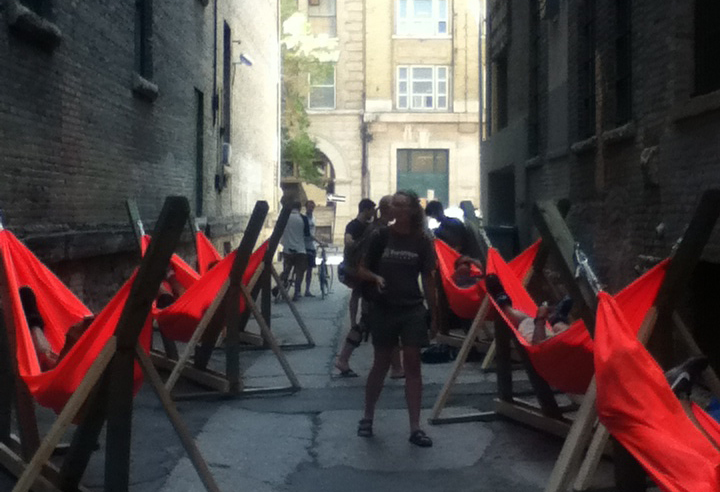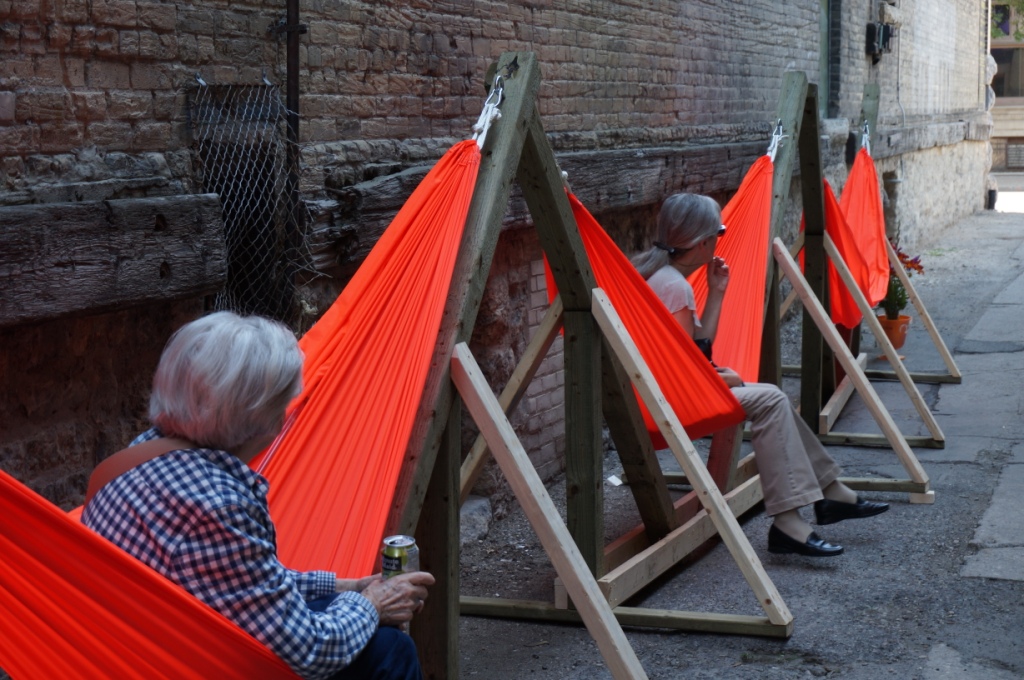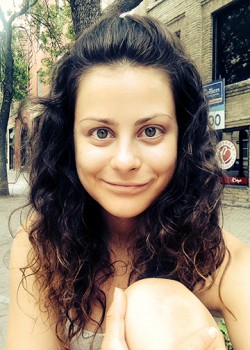
Bright hammocks transform an alleyway as part of Urban Idea's Creative Placemaking Challenge on August 15. // Photo Lorna Parashin
UM students, alumni exhibit their art in Winnipeg alleyways
On a sunny Saturday, Lorna Parashin installed some bright red hammocks in a downtown alleyway and invited passersby to relax a while.
The UM aluma [B.Env.D./’08, M.Arch./’11] and her creative partner, biosystems engineering alumnus Moe Yusim, proposed the “In Full Swing” project for Urban Idea’s Creative Placemaking Challenge. Parashin says she wanted to create something that would allow people to feel comfortable in a downtown alley, initiated by a physiological shift.
Parashin wanted to create something that would allow people to feel comfortable in a downtown alley, initiated by a physiological shift.
The alleyway installation was one of 10 in the Exchange District as part of a day-long event on August 15. All were winning projects from the Placemaking Challenge call for proposals, and each was designed by a creative team and built with a limited budget in a short amount of time. Visitors could walk the entire length of the alleyways, each of which featured one or two installations (many designed by teams with U of M connections, from alumni to instructors).
“The object was very simply, to think about Winnipeg’s iconic spaces and re-imagine, temporarily, how those spaces might be animated,” says Dominic Lloyd, program and arts development manager at the Winnipeg Arts Council (WAC). Urban Idea has existed since the late 1980s but has been in care of the WAC for a few years now, says Lloyd. “[WAC] refined the mandate to be specifically about the relationship between the arts and city building,” and the the purpose of the Creative Placemaking Challenge was “to give creative people some license to re-think the alleys and dray ways of the Exchange, just for a day, to get people thinking about the possibilities.”
The “placemaking” concept has been around for a while in North America. As the Project for Public Spaces organization states, “Placemaking is a quiet movement that reimagines public spaces as the heart of every community, in every city. It’s a transformative approach that inspires people to create and improve their public places. Placemaking strengthens the connections between people and the places they share.”

The “Daygazer” installation — another of the 10 featured projects — by Emily Bews and Ashley James. // Photo Molly Johnson
Parashin’s interest, in architectural terms, has always been to encourage people to think for themselves about how to make their walk or commute or their stay in an urban setting livelier, she says. To that point, she notes, “I liked that this call [for submissions] was open to everyone — it wasn’t limited to designers.”
Part of the impetus for her project was to make something that was “people-driven.” It’s why the team decided against an object-based installation: “We wanted to use the people as the main source.”
The team decided against an object-based installation: “We wanted to use the people as the main source.”
She explains, “The idea was to change something physiologically, in a person’s body, so that they become relaxed.
“And then they are actually able to be in an alleyway comfortably, to let down their guard and experience the space without being either scared or rushed.” A second component of the installation, she adds, was that laying in a hammock literally changes your perspective: “you’re looking up” at the buildings, the sky.
Her approach to space and design is shaped both by her architecture background and her work in yoga, which she teaches. “Through yoga I learned that [in order] to get people to tap into their creative or peaceful or observant side, you have to go through the body first.”
When people were in the hammocks, adds Parashin, you could tell something changed. They may not have thought of transforming a space that way, but, she says, “it works. I wanted people to experience and really feel that experience. Being in a hammock is relaxing, so it definitely works.”
Parashin says that she and her creative partner are planning to continue their hammock project — in its next iteration, three hammocks will be featured as part of PARK(ing) Day Winnipeg on September 19, part of is an annual worldwide event where artists, designers and citizens transform metered parking spots into temporary public parks..








